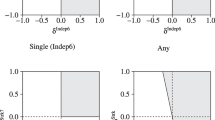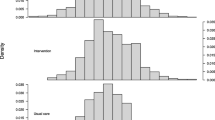Abstract
We formulate a latent variable model with Bayesian estimation to assess a cluster-level intervention effect on multiple binary outcomes from three-level hierarchical data. This approach incorporates the correlation structure into one latent trait, and simultaneously regresses the latent trait on observed covariates. Random effects are included to model the hierarchical structure. We illustrate use of this single-latent trait model in a 32-site cluster randomized clinical trial of a three-arm intervention to improve the quality of pneumonia care. Simulation studies verify the accuracy of the estimation. This latent variable model provides a comprehensive way to analyze multivariate hierarchical data, by estimating intervention effects with respect to multiple binary outcomes, quantifying relationships among outcomes, identifying those outcomes that are most informative regarding the assumed latent trait, and providing a summary measure of the latent trait (e.g., “quality of care”) at each site.




Similar content being viewed by others
References
Fine, M.J., Auble, T.E., Yearly, D.M., Hanusa, B.H., Weissfeld, L.A., Singer, D.E., et al.: A prediction rule to identify low-risk patients with community-acquired pneumonia. N. Engl. J. Med. 336, 243–250 (1997)
Gelman, A.: Prior distribution for variance parameters in hierarchical models. Bayesian Anal. 1, 515–533 (2006)
Gelman, A., Carlin, J.B., Stern, H.S., Rubin, D.B.: Bayesian Data Analysis. Chapman & Hall/CRC, New York (2004)
Gilks, W.R., Thomas, A., Spiegelhalter, D.J.: A language and program for complex Bayesian modeling. The Statistician. 43, 169–177 (1994)
Gray, S.M., Brookmeyer, R.: Estimating a treatment effect from multidimensional longitudinal data. Biometrics. 54, 976–988 (1998)
Janssen, R., Tuerlinckx, F., Meulders, M., Boeck, P.D.: A hierarchical IRT model for criterion-referenced measurement. J. Educ. Behav. Stat. 25, 285–306 (2000)
Landrum, M.B., Bronskill, S.E., Normand, S.-L.T.: Analytic methods for constructing cross-sectional profiles of health care providers. Health Ser. Outcomes Res. Methodol. 1, 23–47 (2000)
Lee, S.Y.: Structural Equation Modeling: a Bayesian Approach. Wiley, London (2007a)
Lee, S.Y.: Handbook of Latent Variable and Related Models. Elsevier, Amsterdam (2007b)
Lee, S.Y., Song, X.Y.: Bayesian analysis of structural equation models with dichotomous variables. Stat. Med. 22, 3073–3088 (2003)
Legler, J.M., Ryan, L.M.: Latent variable models for teratogenesis using multiple binary outcomes. J. Am. Stat. Assoc. 92, 13–20 (1997)
Ntzoufras, I.: Bayesian Modeling Using WinBUGS. Wiley, Amsterdam (2009)
Pocock, S.J., Geller, N.L., Tsiatis, A.A.: The analysis of multiple endpoints in clinical trials. Biometrics. 43, 487–498 (1987)
Rabe-Hesketh, S., Skrondal, A.: Classical latent variable models for medical research. Stat. Methods Med. Res. 17, 5–32 (2008)
Roy, J., Lin, X.: Latent variable models for longitudinal data with multiple continuous outcomes. Biometrics. 56, 1047–1054 (2000)
Sammel, M., Lin, X., Ryan, L.: Multivariate linear mixed models for multiple outcomes. Stat. Med. 18, 2479–2492 (1999)
Skrondal, A., Rabe-Hesketh, S.: Generalized Latent Variable Modeling: Multilevel, Longitudinal, and Structural Equation Models. Chapman & Hall/CRC, Boca Raton (2004)
Spiegelhalter, D.J., Best, N.G., Carlin, B.P., Van der Linde, C.J.: A Bayesian measures of model complexity and fit. J. R. Stat. Soc. B. 64(4), 583–639 (2002)
Spiegelhalter, D.J., Thomas, A., Best, N.G., Lunn, D.: WinBUGS User Manual. Version 1.4. MRC Biostatistics Unit, Cambridge (2003)
Teixeira-Pinto, A., Normand, S.-L.T.: Statistical methodology for classifying units on the basis of multiple-related measures. Stat. Med. 27, 1329–1350 (2008)
Sammel, M.D., Ryan, L.M., Legler, J.M.: Latent variable models for mixed discrete and continuous outcomes. J. R. Stat. Soc. B 59, 667–678 (1997)
Yealy, D.M., Auble, T.E., Stone, R.A., Lave, J.R., Meehan, T.P., Graff, L.G., Fine, J.M., Obrosky, D.S., Edick, S.M., Hough, L.J., Tuozzo, K., Fine, M.J.: The emergency department community acquired pneumonia trial: methodology of a quality improvement intervention. Ann. Emerg. Med. 43, 770–782 (2004)
Yealy, D.M., Auble, T.E., Stone, R.A., Lave, J.R., Meehan, T.P., Graff, L.G., Fine, J.M., Obrosky, D.S., Mor, M.K., Whittle, J., Fine, M.J.: Effect of increasing the intensity of implementing pneumonia guidelines. Ann. Intern. Med. 143, 881–895 (2005)
Zhang, Z., McArdle, J.J., Wang, L., Hamagami, F.: A SAS interface for Bayesian analysis with WinBUGS. Struct. Equ. Model. 15, 705–728 (2008)
Author information
Authors and Affiliations
Corresponding author
Rights and permissions
About this article
Cite this article
Zhao, X., Stone, R.A., Ye, F. et al. A single latent trait model for multiple binary outcomes in a cluster randomized clinical trial. Health Serv Outcomes Res Method 11, 164–178 (2011). https://doi.org/10.1007/s10742-011-0078-2
Received:
Revised:
Accepted:
Published:
Issue Date:
DOI: https://doi.org/10.1007/s10742-011-0078-2




